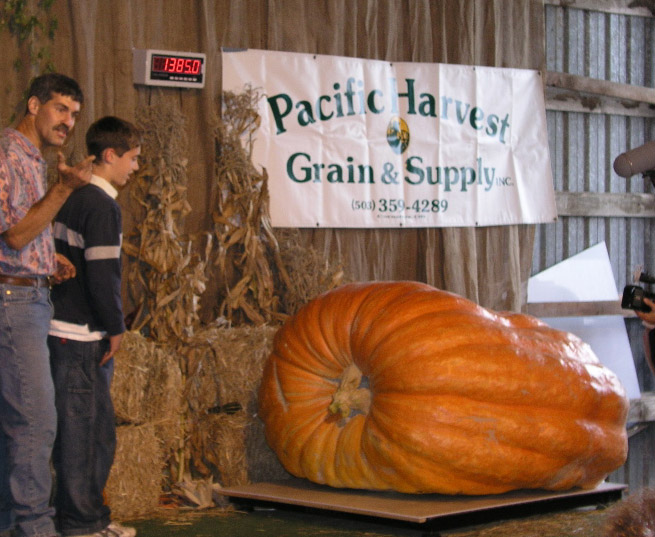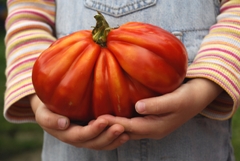doesn't it just make you giggle to say, check out bigpumpkins.com? come on just a little bit? or am i the only child in the room?
Tomato fruit
Botanically, a tomato is the ovary, together with its seeds, of a flowering plant: a fruit or, more precisely, a berry. However, the tomato is not as sweet as those foodstuffs usually called fruits and, from a culinary standpoint, it is typically served as part of a salad or main course of a meal, as are vegetables, rather than at dessert, as are fruits. As noted above, the term "vegetable" has no botanical meaning and is purely a culinary term.
This argument has had legal implications in the United States. In 1887, U.S. tariff laws that imposed a duty on vegetables but not on fruits caused the tomato's status to become a matter of legal importance. The U.S. Supreme Court settled the controversy in 1893 by declaring that the tomato is a vegetable, based on the popular definition that classifies vegetables by use, that they are generally served with dinner and not dessert (Nix v. Hedden (149 U.S. 304)). The holding of the case applies only to the interpretation of the Tariff Act of March 3, 1883, and the court did not purport to reclassify the tomato for botanical or other purposes other than paying a tax under a tariff act.
The tomato has been designated the state vegetable of New Jersey. Arkansas took both sides by declaring the "South Arkansas Vine Ripe Pink Tomato" to be both the state fruit and the state vegetable in the same law, citing both its botanical and culinary classifications. In 2006, the Ohio House of Representatives passed a law that would have declared the tomato to be the official state fruit, but the bill died when the Ohio Senate failed to act on it. Tomato juice has been the official beverage of Ohio since 1965. A.W. Livingston, of Reynoldsburg, Ohio played a large part in popularizing the tomato in the late 1800's.
But due to the scientific definition of a fruit, the tomato remains a fruit when not dealing with US tariffs. Nor is it the only culinary vegetable that is a botanical fruit: eggplants, cucumbers, and squashes of all kinds (such as zucchini and pumpkins) share the same ambiguity.
Wow i am so glad that i live in a state that it's house of Representatives try to pass laws making tomato the state fruit. i am glad they have so much to do with their free time. but i do love tomato's.
this is from a website- tomato's are evil
Originally cultivated by the famously blood thirsty Aztecs and Incas as early as 700 A.D., the tomato is native to the Americas. The Spanish explorer Cortez conquered the Aztec city of Tenochtitlan, later to be renamed Mexico City, in 1521. It is presumed that the tomato found its' way across the Atlantic shortly after. When explorers brought back seed to Europe from Mexico.
The name "tomato" derives from "tomatl," its name in Nahuatl, the language of the Aztec people. The English form "tomate" first appeared in the 17th century, and was later modified to "tomato," probably under the influence of the more familiar "potato." Most of these early fruits were yellow, and became known as "manzanas" (apples) and "pomi d'oro" (apple of gold). They were considered poisonous but appreciated for their beauty.tomatoes are evil and deadly
As the tomato arrived in Europe the plant became associated with poisonous members of the Solanceae family, specifically henbane, mandrake and deadly nightshade, to which it bore more than a passing resemblance. Deadly nightshade is a poisonous plant which has been used as both a hallucinogenic drug and a beauty aid in different parts of Europe. The Latin name "belladonna" means beautiful woman, in the medieval courts of Europe ladies would apply a few drops of nightshade extract to their eyes to dilate their pupils, a look considered most fashionable at the time.
The hallucinogenic properties of the plant, comprised of visions and the sense of flying. This most led to the association of the nightshade family with witchcraft. German folklore claims that witches used plants like mandrake and nightshade to summon werewolves, a practice known as lycanthropy. The common German name for tomatoes translates to "wolf peach", and because of this it was universally avoided. In the 18th century the tomato species was named Lycopersicon esculentum, which literally means, "edible wolf peach".
Despite it's association with Witches and the Black Arts, early efforts to peddle the tomato were not highly successful. Even in one of America's towns most associated with Witchcraft - the hamlet of Salem, Massachusetts a painter hoping to make a little extra money selling the fruit had difficulty even convincing people to taste the red fruit.
The Tomatoes connection with bloodshed continued in Europe. During the French Revolution in 1783 the patriotic Republican citizens of Paris who wore the Red Cap as a mark of faith in the Republic. While thier main aim was beheading aristcrats they still had to eat. They were addressed on one occasion by a zealous chef who suggested that the faithful should eat red food to demonstrate their devotion to the revolution. The Tomato was known to be popular in various southern parts of the continent but was not recommended by the French Aristocracy, making it the perfect mascot for the blood thirsty hordes. It quickly became the fruit of choice to the Republican masses and came to be served as stewed side dishes and as summer salads.
On September 26th, 1830, Colonel Robert Gibbon Johnson stood on the steps of the courthouse in Salem, Massachusetts with a basket of potentially toxic fruit. Despite warnings that its poison would turn his blood to acid, he told several hundred cheering spectators that he planned to eat the entire basket - and survive. "The foolish Colonel will foam and froth at the mouth," his own doctor shouted, "and double over with appendicitis. All that oxalic acid - one dose and he is dead. He might even be exposing himself to brain fever. Should he by some unlikely chance survive his skin will stick to his stomach and cause cancer." Johnson, wearing black, ate the entire basket and indeed survived. The source of this story was an old farm journal, and may be less than reliable. If it is true, he was lucky those fruit were Tomatoes which as the evidence shows are Evil.
tomatoes - a potted history
In 1897, Joseph Campbell came up with the idea of condensed tomato soup - by reducing water in the tin, storage and shipping costs were reduced.
Campbell's soup packaging later became iconic when Andy Warhol used the image in more than 100 pop-art works. According to art myth: Andy Warhol's mother served him tomato soup for lunch for twenty years which was why he painted tomato soup cans.
Andy Warhol was known for dissolving the boundaries between high and low culture: he used silkscreening techniques to mechanically reproduce consumer images such Campbell's soup cans.
Also in the late sixties sci-fi flick Attack of the Killer Tomatoes was released, so sucessful was this characterising of the evil fruit that a sequel was later made.
In 1948 Tomato juice is combined with other juices in V8 Vegetable juice which was acquired by Campbell's. It advertised it, using movie actor Ronald Reagan as a spokesman, among others.
In 1981, the USDA chairman declared ketchup to be a vegetable in order to justify Reagan administration budget cuts in the school lunch program. President Nixon covered his cottage cheese with Tomato Ketchup.(see also tomato health facts)
Do NOT allow this abomination into your food, your fridges or your lives.How much more proof do you need?




No comments:
Post a Comment